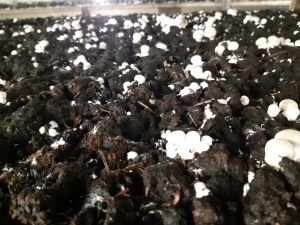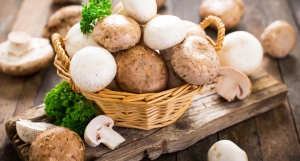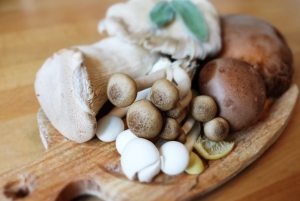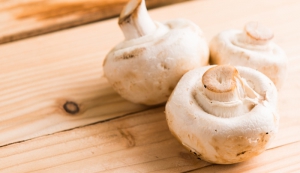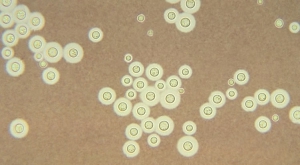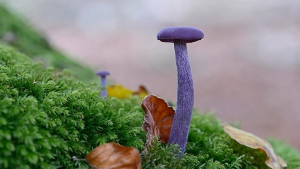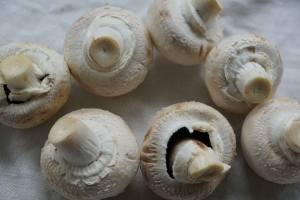And on the 7th day
An appropriate title for a blog written on Easter Monday.
Normally the 7th day is a day of rest. Good for people after a week of working but not always good if mushrooms take a rest. Read: they stop growing. This can happen during the fructification and if the reaction of the grower is too slow, the flush grows out to be too small.
Fructification is split into two sections. 4 to 5 days for making the mushrooms or forming the primordia. The second part is roughly from day 5 till the start of the first flush. During the first part RH, ambient temperature and CO2 are the main parameters to control the number of primordia. Compost temperature is for me not that important at that time. After day 5 the RH is lowered to let the primordia grow out to be mushrooms. The CO2 is dropped slowly and we also start dropping the temperature to reach 17.5° C ambient temperature at the start of the flush (my favourite temperature to work with).
On day 7 one can see mushrooms developing in the size of 2 to 5 millimetres. And then this phenomenon can occur. You look during your morning check and everything looks good. The next day, nothing has happened. General reaction is waiting. But if you look carefully, in most of the cases the room is not taking enough fresh air. CO2 is okay, RH is okay, air temperature is okay and the compost temperature is declining. If the minimum fresh air setting is too low, the room can have a lack of oxygen and mushrooms just stop developing. Simplest thing to do is to drop the CO2 setting to 800 ppm for a couple of hours. To avoid this however and the best way to handle this, is to make sure that the minimum fresh air setting is around 25%. Then the climate unit will always use enough fresh air and mushrooms keep growing. By the way, this happens mostly with strains which tend to give bigger mushrooms. Because they already tend to give fewer mushrooms.
Help us with our positive mushroom campaign!
We are all experiencing difficult and challenging times. Times we have never experienced before and hopefully we can all recover from it. Our health is the most important thing to focus on as well as taking care of eachother. Maybe we are even more closer than ever!
This corona virus has besides to our health, also a large impact on mushroom businesses, hopefully you all have found ways to cope with it. Maybe even accelerate your innovation roadmap!
We as Mushroom Matter haved asked ourselves the question how we can become more closer and more meaningful to people around the globe during this period. So we are going to focus on the health benefits of mushrooms and make sure that the mushroom finds it's way to the consumer even more.
We are starting a positive mushroom campaign on our website and social media channels #mushroomsmatterforyourhealth and would kindly appreciate your help by sending us information you have on mushrooms and why they are so important for our health and future*. Please send us your input to This email address is being protected from spambots. You need JavaScript enabled to view it.
* information we are allowed to use in relation to GDPR and authorship
Feed Your Immune System
The immune system is made up of a network of cells, tissues and organs that work together to protect the body against infection and maintain overall health. Mushrooms, like other fruits and vegetables, can play a positive role in supporting a healthy immune system.
The 2015-2020 Dietary Guidelines for Americans1 emphasizes the importance of creating a healthy eating pattern to maintain health and reduce the risk of disease. Suggestions include:
• Make half your plate fruits and vegetables.
• Move to low-fat and fat-free milk or yogurt.
• Make half your grains whole grains.
• Focus on whole fruits and vary your vegetables.
• Drink and eat less sodium, saturated fat and added sugars.
• Vary your protein routine.
Nutrients Important for Overall WellnessThere are a variety of micronutrients, as identified by the Linus Pauling Institute at Oregon State University2, that are important for supporting a healthy immune system including selenium and vitamins D and B6, which can be found in mushrooms.
As COVID-19 tightens its grip on the world, more and more of us are naturally looking for ways to help stave of contracting the virus, whether it’s for ourselves, or to protect those around us who might be at higher risk of developing serious complications.
But while there’s no vaccine to ward off coronavirus (though scientists around the world are working tirelessly on creating one) there are some easy, natural steps you can take to strengthen your immune system to help you fight of this virus, and illnesses like it.
Read the full article here.
The coronavirus presents many uncertainties, and none of us can completely eliminate our risk of getting COVID-19. But one thing we can do is eat as healthily as possible.
If we do catch COVID-19, our immune system is responsible for fighting it. Research shows improving nutrition helps support optimal immune function.
Micronutrients essential to fight infection include vitamins A, B, C, D, and E, and the minerals iron, selenium, and zinc.
Here’s what we know about how these nutrients support our immune system and the foods we can eat to get them.
Fungi That 'Eat' Radiation Are Growing on the Walls of Chernobyl's Ruined Nuclear Reactor
Back in 1991, scientists were amazed when they made the discovery...
In the eerie environment inside the abandoned Chernobyl Nuclear Power Plant, researchers remotely piloting robots spotted pitch black fungi growing on the walls of the decimated No. 4 nuclear reactor and even apparently breaking down radioactive graphite from the core itself. What's more, the fungi seemed to be growing towards sources of radiation, as if the microbes were attracted to them!
More than a decade later, University of Saskatchewan Professor Ekaterina Dadachova (then at the Albert Einstein College of Medicine in New York) and her colleagues acquired some of the fungi and found that they grew faster in the presence of radiation compared to other fungi. The three species tested, Cladosporium sphaerospermum, Cryptococcus neoformans and Wangiella dermatitidis, all had large amounts of the pigment melanin, which is found – among many places – in the skin of humans. People with a darker skin tone have much more of it. Melanin is known to absorb light and dissipate ultraviolet radiation, but in the fungi, it seemed to also be absorbing radiation and converting it into chemical energy for growth, perhaps in a similar fashion to how plants utilize the green pigment chlorophyll to attain energy from photosynthesis.
Back in 1991, scientists were amazed when they made the discovery...
In the eerie environment inside the abandoned Chernobyl Nuclear Power Plant, researchers remotely piloting robots spotted pitch black fungi growing on the walls of the decimated No. 4 nuclear reactor and even apparently breaking down radioactive graphite from the core itself. What's more, the fungi seemed to be growing towards sources of radiation, as if the microbes were attracted to them!
More than a decade later, University of Saskatchewan Professor Ekaterina Dadachova (then at the Albert Einstein College of Medicine in New York) and her colleagues acquired some of the fungi and found that they grew faster in the presence of radiation compared to other fungi. The three species tested, Cladosporium sphaerospermum, Cryptococcus neoformans and Wangiella dermatitidis, all had large amounts of the pigment melanin, which is found – among many places – in the skin of humans. People with a darker skin tone have much more of it. Melanin is known to absorb light and dissipate ultraviolet radiation, but in the fungi, it seemed to also be absorbing radiation and converting it into chemical energy for growth, perhaps in a similar fashion to how plants utilize the green pigment chlorophyll to attain energy from photosynthesis.
Click here for the full article
Source: RealClear Science By Ross Pomeroy - RCP Staff
The world of fungi is wonderful, weird and wild thanks to its rich palette of colors, strange shapes and infinite textures. Contrary to what you've been told, not all colorful mushrooms are deadly, like the red fly agaric. Below are two violet mushrooms that are edible and one beautiful blue mushroom that nobody dares to consume.
Photo above is of an Amethyst Deceiver (Laccaria amethystina)
The amethyst deceiver has a bright lilac color. Its cap and stem become paler and almost white in dry environments or as the mushroom grows older, making it hard to recognize. Thus, the name "deceiver". The violet mushroom can be found in leaf litter of coniferous and deciduous woodland during late summer and autumn. Though people often think that colorful mushrooms are toxic, the amethyst deceiver is edible.
Read the full article and about more edible mushrooms on the webiste of GGTN.
UNIVERSITY PARK, Pa. — Mushrooms contain unusually high amounts of two antioxidants that some scientists suggest could help fight aging and bolster health, according to a team of Penn State researchers.
In a study, researchers found that mushrooms have high amounts of ergothioneine and glutathione, both important antioxidants, said Robert Beelman, professor emeritus of food science and director of the Penn State Center for Plant and Mushroom Products for Health. He added that the researchers also found that the amounts of the two compounds varied greatly between mushroom species.
"What we found is that, without a doubt, mushrooms are the highest dietary source of these two antioxidants taken together, and that some types are really packed with both of them," said Beelman.
Beelman said that when the body uses food to produce energy, it also causes oxidative stress because some free radicals are produced. Free radicals are oxygen atoms with unpaired electrons that cause damage to cells, proteins and even DNA as these highly reactive atoms travel through the body seeking to pair up with other electrons.
Replenishing antioxidants in the body, then, may help protect against this oxidative stress.
"There's a theory — the free radical theory of aging — that's been around for a long time that says when we oxidize our food to produce energy there's a number of free radicals that are produced that are side products of that action and many of these are quite toxic," said Beelman. "The body has mechanisms to control most of them, including ergothioneine and glutathione, but eventually enough accrue to cause damage, which has been associated with many of the diseases of aging, like cancer, coronary heart disease and Alzheimer's."
According to the researchers, who report their findings in a recent issue of Food Chemistry, the amounts of ergothioneine and glutathione in mushrooms vary by species with the porcini species, a wild variety, containing the highest amount of the two compounds among the 13 species tested.
"We found that the porcini has the highest, by far, of any we tested," said Beelman. "This species is really popular in Italy where searching for it has become a national pastime."
The more common mushroom types, like the white button, had less of the antioxidants, but had higher amounts than most other foods, Beelman said.
The amount of ergothioneine and glutathione also appear to be correlated in mushrooms, the researchers said. Mushrooms that are high in glutathione are also high in ergothioneine, for example.
Cooking mushrooms does not seem to significantly affect the compounds, Beelman said.
"Ergothioneine is very heat stable," said Beelman.
Beelman said that future research may look at any role that ergothioneine and glutathione have in decreasing the likelihood of neurodegenerative diseases, such as Parkinson's disease and Alzheimer's disease.
"It's preliminary, but you can see that countries that have more ergothioneine in their diets, countries like France and Italy, also have lower incidences of neurodegenerative diseases, while people in countries like the United States, which has low amounts of ergothioneine in the diet, have a higher probability of diseases like Parkinson's Disease and Alzheimer's," said Beelman. "Now, whether that's just a correlation or causative, we don't know. But, it's something to look into, especially because the difference between the countries with low rates of neurodegenerative diseases is about 3 milligrams per day, which is about five button mushrooms each day."
Beelman worked with Michael D. Kalaras, postdoctoral assistant in food sciences; John P. Richie, professor of public health sciences and pharmacology; and Ana Calcagnotto, research assistant in public health sciences.
Source: PennState
A future where a key ingredient of psychedelic mushrooms called psilocybin is regularly used to improve our mental health is none too far off. This month, the Food and Drug Administration (FDA) granted a “breakthrough therapy” designation to a non-profit company developing psilocybin as a treatment for clinical depression. The label is intended to speed up the review process needed for approval.
As far back as the 1970s, some therapists have used the mind-altering effects of hallucinogenic compounds like psilocybin to treat their patients’ depression or anxiety (usually alongside conventional therapy). But as these compounds became popular recreational drugs, governments around the world banned their use entirely, including in a medical setting. Over the years, though, advocates have slowly convinced regulatory agencies like the FDA to reconsider this stance, especially given the lack of options available to people who don’t respond to typical antidepressants (which may be as high as 55 percent of all patients).
Author: Ed Cara
Read the full articel here














